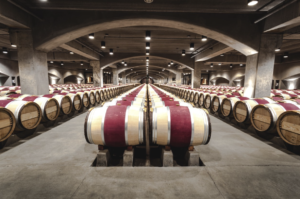
Wood Wine Barrels (Courtesy of Getty Images 2018).
“Wine can be a better teacher than ink, and banter is often better than books.” ~ S. Frye
“I love wine. And while I have had my fair share of awesome vintages, one of the great wine-drinking experiences was drinking wine that was produced in a concrete wine vessel.” ~ J.Belkowitz
Many years ago a client and good friend asked me if I had ever heard about concrete wine vessels. I was unaware of anything like in my travels and studies.
Supposedly, there were a few concrete wine vessel manufacturers in California and even better, there were some wine companies in Napa Valley using these new vessels.
Our client approached us with a request:
“Would you (Dr Belkowitz) like to conduct a research project in Napa Valley on the impact of concrete wine vessels on wine in Napa?”
…
Dr. Belkowitz’s response to the research project and trip.

Dr. Belkowitz after he found out about the concrete wine vessel research project.
The following notes are from that trip to Napa:
Facts
What is a concrete wine vessel?
A concrete wine vessel is a vessel used in the wine vinting, storage, and/or distribution process that is made partially or entirely out of concrete.
Although concrete wine vessels have been around for centuries, the modern egg shape has revolutionized the wine industry.
Why concrete wine vessels?
The egg-shaped vessel, along with the less common cube, cone, and pyramid-shaped vessels, allows for the stabilization of temperature throughout the fermentation process. This is due to concrete’s ability as a natural insulator.
When compared to steel and oak vessels, concrete is a relatively inexpensive and renewable material that allows for slow oxygenation of the wine through the concrete pores.
Most importantly, through my taste tests, the concrete wine vessels allow the true flavor of the grape to come through.
What is concrete wine vessels made from?
There are two basic types of concrete wine vessels: treated vessels and untreated vessels. Treated vessels are lined with a food-grade resin coating or square glass tiles, while untreated are bare concrete walls. There is a possibility to treat the concrete with food-grade colloidal silica to densify and seal the concrete surface.
Often winemakers add used whiskey barrel slats, strips of American or French oak, or wood chips from used whiskey barrels for flavor.
Will the Wine from Concrete Wine Vessels Kill Me?
First of all, WINE FROM CONCRETE WINE VESSELS DID NOT KILL ME.
The wine we drank from the concrete wine vessels was amazing.
That being said, the concrete mixtures and construction practices for concrete wine vessels are not regulated as much as I thought they would be.
The wines we drank (Chardonnay and Cabernet Sauvignon) were produced in concrete wine vessels that were NOT NSF 61 certified.
When compared to the same grape cured in a steel and oak vessel, you could taste what I would only call the ‘true flavor of the grape along with some minerals flavors. The same grape from the steel vessel tasted like it had metal filings floating in the wine. While the wine produced in the oak barrels had the traditional vanilla, nutty, and tobacco tastes.
If you are going down the road of concrete wine vessels for your production line, please make sure you ask the following:
“Have you received an NSF 61 certification for the concrete mixture used in the construction of the vessel?”
My chief concern is the long-term impact of the deterioration of the exposed concrete during the wine curing process. Throughout the 6-week process (and possibly longer time for storage), untreated concrete can break down due to the chemical mechanism of the vinting process. When people say, “concrete wine vessels don’t impart any flavors, it’s the true mineral and earthy flavor of the grape†they are tasting the tiniest bit of concrete. That is unless the concrete wine vessel is treated with a food-grade coating. If there were chemicals in the concrete that weren’t meant for human consumption, then folks COULD POSSIBLY get sick. I have yet to hear of that occurring.
Final Thoughts
The use of concrete wine vessels has reemerged from the annals of history to meet the increasing demand for wine consumption and to satisfy the palate of the wine connoisseur and wine novice.
We are excited to see how concrete wine vessels construction and concrete mixtures evolve as the trend continues to grow.
We believe the following are directions and technologies that will be implemented into concrete wine vessel manufacturing in the next 5 years:
- Construction Practice
— Construction of perforated concrete walls in the vessels to assist in circulation during the vinting process
— Standardization and implementation of ‘Food-Grade’ concrete practices and quality control measures.
— Incorporating shotcrete, gunite, and stamping practices to construct custom-style vessels.
- Concrete Mix Designs
— Incorporation of nanoparticles in the concrete, such as colloidal silica, to densify the concrete and increase the resistivity to chemical deterioration.
— Use of ultra-lightweight concrete to reduce the weight of the vessels
— Standardization and implementation of ‘Food-Grade’ concrete mixtures and quality control measures.
Once these technologies have been implemented, I will personally take the responsibility of researching the wines once again and reporting my findings…

It would seem to be the wine would easily seep through or be absorbed into the concrete matrix of an u treated concrete barrel. Furthermore, I would expect the alkalinity of the wine to increase dramatically.
Exactly.